Norse mythology has its roots in Proto-Norse Nordic prehistory. It flourished during and after the Christianization of Scandinavia, during the High Middle Ages, and passed into Nordic folklore, with some aspects surviving to the modern day. The mythology from the Romanticist Viking revival came to be an influence on modern literature and popular culture.
Most of the existing records on Norse mythology date from the 11th to 18th century, having gone through more than two centuries of oral preservation in what was at least officially a Christian society. At this point, scholars started recording it, particularly in the Eddas and the Heimskringla by Snorri Sturluson, who believed that pre-Christian deities trace real historical people.
Here are some of the most popular Norse Symbols that have arisen from their time.
 Hrunger`s Heart – This Norse symbol was first found on old Norse stone carvings called The Valknut, which is also called “Hrungnir’s heart,” for the giant Hrungnir of the Eddas and is best known as the Valknut, or”knot of the slain.” It has been found on several stone carvings with funerary motifs, as it is thought to signify the afterlife. The Valknut’s three interlocking shapes and nine points are sometimes used to represent rebirth, pregnancy, and cycles of reincarnation. The nine points are also suggestive of the Nine Worlds. Their interwoven shape also suggests the interrelatedness of the three realms of earth, hell, and the heavens and the nine domains they encompass. Hrunger`s Heart – This Norse symbol was first found on old Norse stone carvings called The Valknut, which is also called “Hrungnir’s heart,” for the giant Hrungnir of the Eddas and is best known as the Valknut, or”knot of the slain.” It has been found on several stone carvings with funerary motifs, as it is thought to signify the afterlife. The Valknut’s three interlocking shapes and nine points are sometimes used to represent rebirth, pregnancy, and cycles of reincarnation. The nine points are also suggestive of the Nine Worlds. Their interwoven shape also suggests the interrelatedness of the three realms of earth, hell, and the heavens and the nine domains they encompass. |
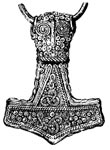 Mjolnir Pendant – Mjolnir pendants were worn by Norse pagans during the 9th to 10th centuries. Mjolnir Pendant – Mjolnir pendants were worn by Norse pagans during the 9th to 10th centuries. |
|
|
 Ydun – In Norse mythology, Ydun is a goddess associated with apples and youth. Ydun – In Norse mythology, Ydun is a goddess associated with apples and youth. |
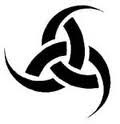 Odin`s Horn – The Triple Horn of Odin is made of three interlocking drinking horns and represents Odin, the father of Norse gods. The horns are significant in the Norse Eddas and feature prominently in elaborate toasting rituals. In some stories, the horns represent the three draughts of the Odhroerir, a magical mead. Odin`s Horn – The Triple Horn of Odin is made of three interlocking drinking horns and represents Odin, the father of Norse gods. The horns are significant in the Norse Eddas and feature prominently in elaborate toasting rituals. In some stories, the horns represent the three draughts of the Odhroerir, a magical mead. |
 Sleipnir – In Norse mythology, Odin, the father of all gods, rides on an eight-legged horse named Sleipnir. This powerful and magical creature appears in both the Poetic and Prose Eddas. Images of Sleipnir have been found on stone carvings dating back as far as the eighth century. Many scholars believe that Sleipnir, with his eight legs instead of the usual four, represents the shamanic journey, which implies that this horse’s origins may go far back into Proto-Indo-European religion. Sleipnir – In Norse mythology, Odin, the father of all gods, rides on an eight-legged horse named Sleipnir. This powerful and magical creature appears in both the Poetic and Prose Eddas. Images of Sleipnir have been found on stone carvings dating back as far as the eighth century. Many scholars believe that Sleipnir, with his eight legs instead of the usual four, represents the shamanic journey, which implies that this horse’s origins may go far back into Proto-Indo-European religion. |
Thor`s Hamm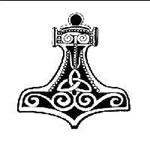 er (also called Mjolnir) Typically used in Pagan traditions with a Norse background, such as Asatru, this symbol represents the power of Thor over lightning and thunder. The early Pagan Norsemen wore the Hammer as an amulet of protection long after Christianity had moved into their world, and it is still worn today, both by Asatruar and others of Norse heritage. er (also called Mjolnir) Typically used in Pagan traditions with a Norse background, such as Asatru, this symbol represents the power of Thor over lightning and thunder. The early Pagan Norsemen wore the Hammer as an amulet of protection long after Christianity had moved into their world, and it is still worn today, both by Asatruar and others of Norse heritage. |
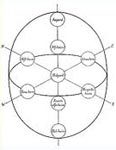 Nine Worlds Symbol – The cosmology of Norse mythology has ‘nine homeworlds,’ unified by the world tree Yggdrasill. Mapping the nine worlds escapes precision because the Poetic Edda often alludes vaguely, and medieval Christian cosmology may influence the Prose Edda. The Norse creation myth tells how everything came into existence in the gap between fire and ice and how the gods shaped the homeworld of humans. Nine Worlds Symbol – The cosmology of Norse mythology has ‘nine homeworlds,’ unified by the world tree Yggdrasill. Mapping the nine worlds escapes precision because the Poetic Edda often alludes vaguely, and medieval Christian cosmology may influence the Prose Edda. The Norse creation myth tells how everything came into existence in the gap between fire and ice and how the gods shaped the homeworld of humans. |
|
|
 Gungnir – In Norse mythology, Gungnir is Odin’s magical spear; it always hits its mark and always kills. Gungnir – In Norse mythology, Gungnir is Odin’s magical spear; it always hits its mark and always kills. |

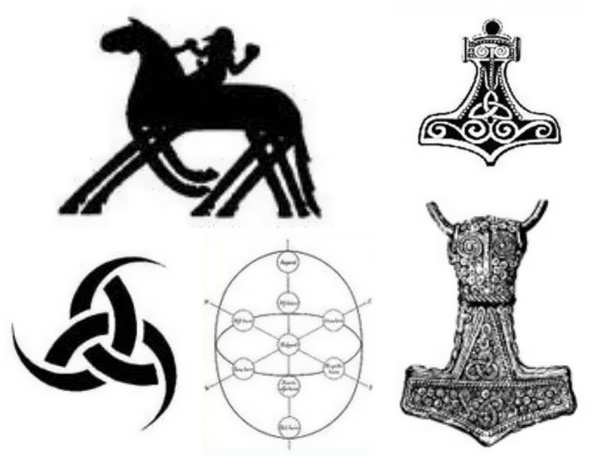
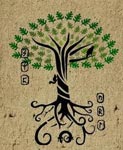 Yggdrasil – In Norse mythology, Yggdrasil is an immense tree central in Norse cosmology; the world tree and nine worlds existed around the tree. It generally means “Ygg’s (Odin’s) horse.” Yggdrasil is an immense ash tree that is central and considered very holy.
Yggdrasil – In Norse mythology, Yggdrasil is an immense tree central in Norse cosmology; the world tree and nine worlds existed around the tree. It generally means “Ygg’s (Odin’s) horse.” Yggdrasil is an immense ash tree that is central and considered very holy. Jormungand – In Norse mythology, Jormungand, also known as Midgard Serpent or World Serpent, is a sea serpent and the middle child of the giantess Angrboða and the god Loki. According to the Prose Edda, Odin took Loki’s three children, Fenrisulfr, Hel, and Jormungandr, and tossed Jormungandr into the great ocean that encircles Midgard. The serpent grew so large that he was able to surround the Earth and grasp his own tail. When he lets go, the world will end. As a result, he earned the alternate name of the Midgard Serpent or World Serpent. Jörmungandr’s arch-enemy is the god Thor.
Jormungand – In Norse mythology, Jormungand, also known as Midgard Serpent or World Serpent, is a sea serpent and the middle child of the giantess Angrboða and the god Loki. According to the Prose Edda, Odin took Loki’s three children, Fenrisulfr, Hel, and Jormungandr, and tossed Jormungandr into the great ocean that encircles Midgard. The serpent grew so large that he was able to surround the Earth and grasp his own tail. When he lets go, the world will end. As a result, he earned the alternate name of the Midgard Serpent or World Serpent. Jörmungandr’s arch-enemy is the god Thor.